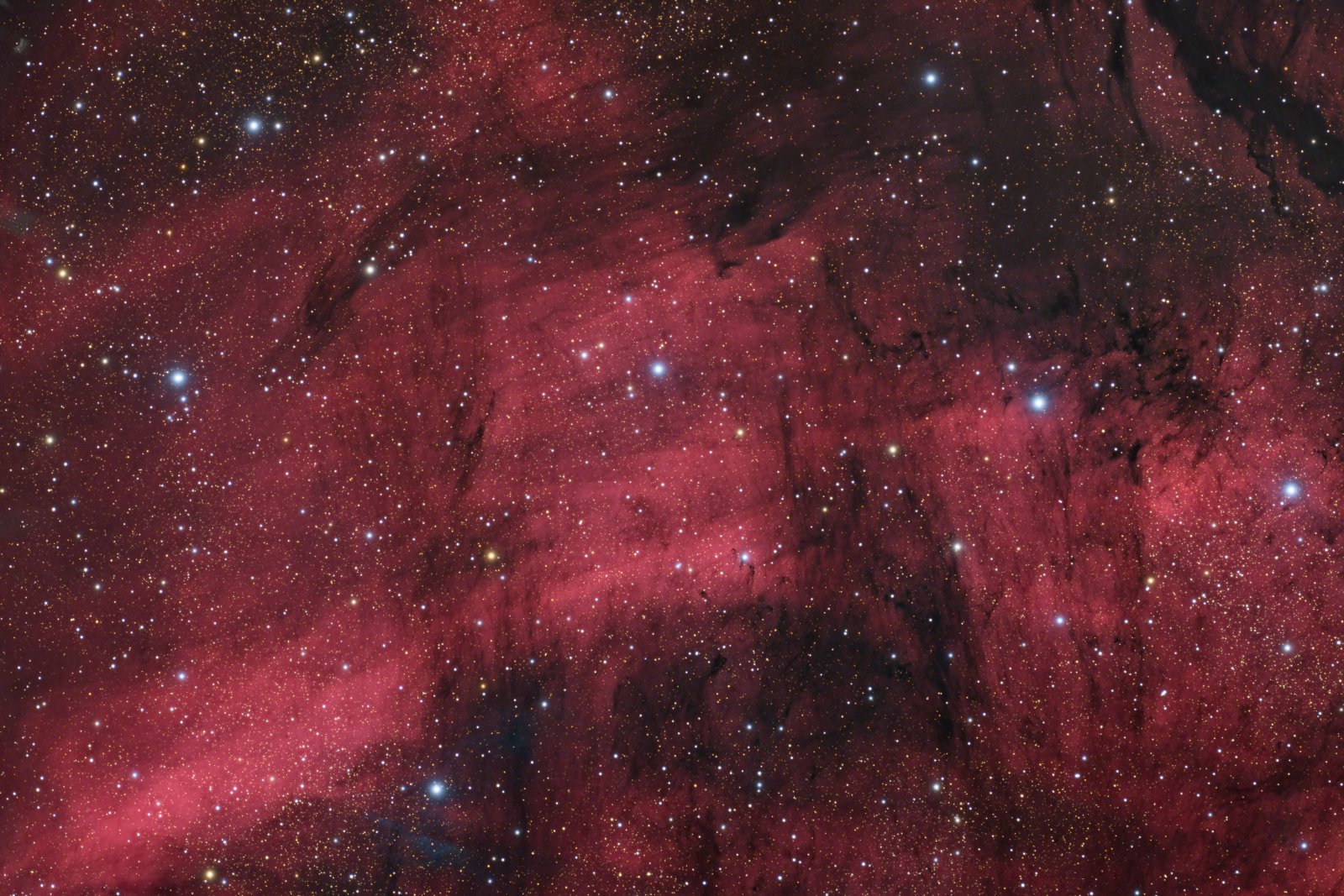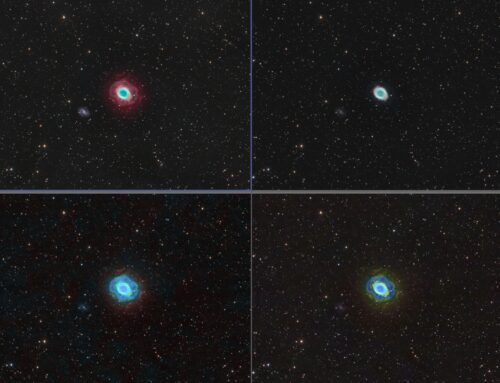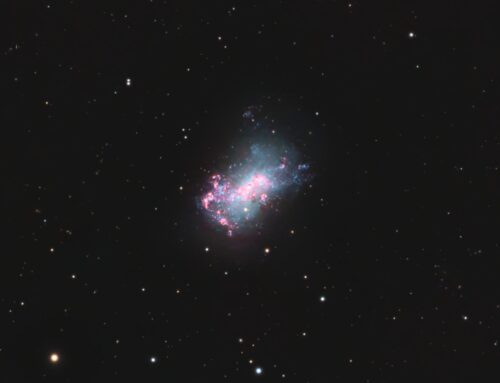IC 5068 Region
 Click image for full size version
Click image for full size version
October 16, 2021
IC 5068 lies “beneath” the Pelican nebula. Both can be seen together in wide field images. IC 5068 looks like a parallelogram with diagonal extensions at bottom left and top right. Like the other patches of glowing gas in this region, this nebula lies around 1,600 light years away, and glows in red wavelengths due to emissions from hydrogen atoms. There are also several other objects in the field which are identified in an annotated image.
To create this photo I blended the light collected through two telescopes. A smaller telescope (4″ refractor) was used to capture relatively low resolution one-shot colour, and a larger telescope (6″ refractor) and monochrome camera were used to collect higher resolution Luminance. An H-alpha filter was used with the high resolution setup to capture the mainly red light of hydrogen in this region. For comparison, check out my previously-posted close-ups of IC 5068, including H-alpha only, in black-and-white.
Tekkies:
Acquisition, focusing, and control of Paramount MX mount with N.I.N.A., TheSkyX and PHD2. Focus with Optec DirectSync motor and controller. Equipment control with PrimaLuce Labs Eagle 4 Pro computer. All pre-processing and processing in PixInsight. Acquired from my SkyShed in Guelph. Average or better transparency and seeing. Data acquired August 12 – September 30, 2021.
Luminance: Sky-Watcher Esprit 150 f/7 refractor and QHY600M camera with Optolong UV/IR filter
Chrominance: Takahashi FSQ-106 ED IV @ f/5 and QHY367C Pro one-shot colour camera with Optolong UV/IR filter
Data Reduction and Initial Processing
Preprocessing: The WeightedBatchPreProcessing script was used to create Luminance and H-alpha master frames from the mono camera and an RGB master frame from the one-shot colour camera. DrizzleIntegration (2x CFA Drizzle) was applied to the RGB set. The RGB master was registered to the Luminance master using StarAlignment.
Gradient Removal: DBE was applied to each of the three masters using Subtraction.
Colour
Colour Balance: Colour was balanced with PhotometricColorCalibration.
Linear Noise Reduction: MultiscaleLinearTransform was used to reduce noise in the background areas, using an internal mask to protect bright structures. Layer settings for threshold and strength: Layer 1: 5.0 0.85, 1 iteration; Layer 2: 4.0, 0.75, 1 iteration, Layer 3: 3.3 0.65, 1 iteration; Layer 4: 1.0, 0.35, 1 iteration.
Stretching: HistogramTransformation was applied to make a pleasing, bright image, with background set to an intensity of approximately 0.10.
Lightness and H-alpha
Deconvolution: A star mask was made from the Luminance master to use as a Local Deringing Support Image. A stretched clone of the H-alpha image was used to make a mask selecting bright regions of the nebula for deconvolution. Deconvolution was applied (30 iterations, regularized Richardson-Lucy, ParametricPSF mode with default settings; Global dark deringing = 0.02; Global bright deringing 0.007).
Linear Noise Reduction: MultiscaleLinearTransform was used to reduce noise in the background areas, using an internal mask to protect bright stars. Layer settings for threshold and strength: Layer 1: 5.0 0.75, 1 iteration; Layer 2: 4.0, 0.6, 1 iteration, Layer 3: 3.3 0.5, 1 iteration; Layer 4: 1.0, 0.25, 1 iteration.
Stretching: HistogramTransformation was applied to make a pleasing, bright image, with background set to an intensity of approximately 0.10.
Combining Lightness, H-alpha and Colour Images
LRGB Combination: The lightness image was applied to the RGB image using LRGBCombination with default settings.
H-alpha Blending: PixelMath was used to add H-alpha to the LRGB image (the target image, $T), using the following expressions for the R, G and B channels:
R: max($T[0], 1.2*Ha)
G: $T[1]
B: iif($T[0]<Ha, $T[2] + 0.06*Ha, $T[2])
Additional Processing
Nonlinear Noise Reduction: TGVDenoise was used in L*a*b* mode to reduce noise with a mask used to target the background areas and protect the stars and nebula (max. 1,000 iterations and convergence selected for both lightness and chrominance).
Contrast Enhancement: LocalHistogramEqualization was applied using an inverted star mask to protect the stars (scale 50, max contrast 1.5, strength 0.25, 1 iteration, followed by scale 150, max contrast 1.5, strength 0.35).
Sharpening: MultiscaleLinearTransform was used to sharpen Layers 2 and 3 with strengths of 0.2 and 0.13, respectively. A mask was made by subtracting a star mask from the mask used for deconvolution. This was used to limit sharpening to a few specific regions of the image, while avoiding sharpening the stars.
Final Steps: MorphologicalTransformation was applied (morphological selection=0.11; strength =1; 9×9 kernel, circular structure) through a star mask to slightly reduce the size of the largest stars. The DarkStructureEnhance script was applied with a strength of 0.2. Background, nebula and star brightness, contrast and saturation were adjusted in several iterations using CurvesTransformation with masks as required. ICCProfileTransformation (sRGB IEC61966-2.1; Relative Colorimetric with black point compensation) was applied prior to saving as a jpg.






Gorgeous image! Like always!
This one seems so structured. Beautiful picture.
Gratulacje – piękne zdjęcia. Pozdrawiam